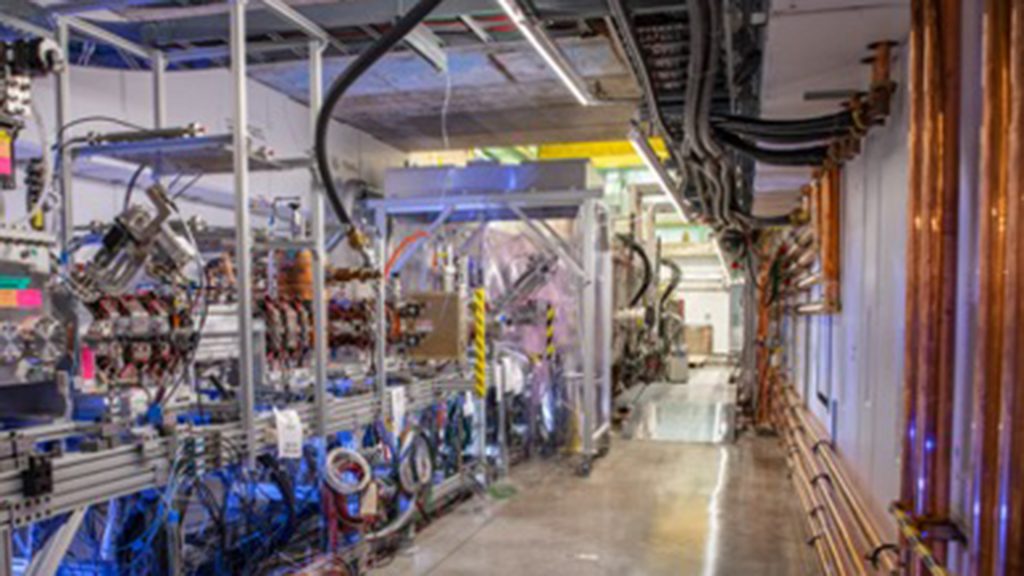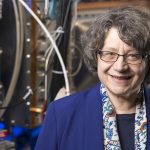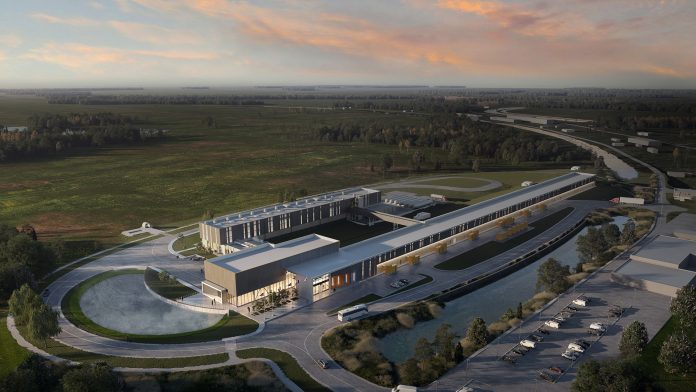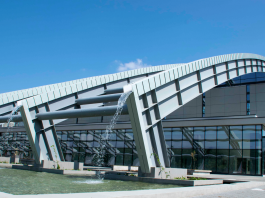Lia Merminga, Project Director of PIP-II, explains the progress made in the major PIP-II enhancement to the Fermilab accelerator complex.
The U.S. Department of Energy’s Fermi National Accelerator Laboratory is a premiere particle physics and accelerator laboratory, offering a range of advanced particle accelerators since 1967 to help users answer fundamental questions regarding the matter of the Universe. Currently, the Fermilab accelerator complex is undergoing a major upgrade, referred to as the Proton Improvement Plan II (PIP-II).
Once complete, PIP-II will accelerate protons at up to 800-million-electronvolts (MeV), over its 215-metre length, with a beam power of over one megawatt (MW) in the 60 to 120 giga-electronvolts (GeV) energy range. This will power the most intense high-energy neutrino beam on its journey from Illinois to the Deep Underground Neutrino Experiment (DUNE) in South Dakota – a distance of 1,300km (800 miles).
Simultaneously, the high-power proton beams delivered by PIP-II will also enable muon-based experiments to search for new particles and forces at unprecedented levels of precision, alongside driving a broad physics research programme.
The PIP-II project is a first-of-its-kind international collaboration for a U.S. Department of Energy (DOE) accelerator, with input from research institutions in India, the UK, Italy, France, and Poland. The upgrade is scheduled to be complete by 2028.
To discover more about the project’s progress and the broad range of capabilities the enhancement will enable, The Innovation Platform spoke to Lia Merminga, Project Director of PIP-II.
What is the current status of the PIP-II project?
The project is currently at the final design stage, with parts of it already under construction. The performance baseline of the PIP-II project – including the schedule, scope, performance, and cost – was approved by the DOE in December 2020. This allowed us to progress to the final designs and towards the execution of the project.
Construction of the cryogenic plant building began in summer 2020 and is scheduled to be completed in June 2022. The site work construction started in December 2021 and should be complete in October of this year. The design for the Linac complex, which includes the tunnel that will house the accelerator and a building on the ground known as the Linac Gallery, is 100% complete. The final piece of the civil construction is a beamline that connects to the existing booster accelerator and its design is scheduled to be completed in February 2022.
Many of the technical systems of the accelerator have been built as prototypes and their performance has been validated in the PIP-II Injector Test (PIP2IT) facility – a systems integration testbed for PIP-II critical technologies. This facility replicates roughly the first 20 metres of the PIP-II accelerator, including its warm front end and the first two cryomodules (vessels that house and insulate superconducting radio-frequency cavities at ultracold temperatures). Within the PIP2IT, we carried out comprehensive beam testing and validated the performance of numerous systems that will be installed in the final PIP-II accelerator.
To enter full construction, we need one more authorisation from the DOE, which we hope to receive in March. Following this, full construction of the Linac complex and the technical systems can begin.
Why is the PIP-II enhancement required and what will it achieve?
PIP-II is an essential upgrade to the Fermilab accelerator complex to enable the world’s most intense and wide-band neutrino beam to the Long-Baseline Neutrino Facility (LBNF) and DUNE. Powered by PIP-II’s competitive advantage, DUNE is designed to be a ‘best-in-class’ experiment to deliver world-leading precision neutrino physics. The Particle Physics Project Prioritization Panel (P5) report, released in 2014, delineates a strategic plan for US high energy physics in the global context. This report called for building a world-class neutrino programme hosted by the US as a global project, and more than a megawatt of proton beam power out of the Fermilab accelerator complex for the LBNF and DUNE.
PIP-II will enable the site to reach more than a megawatt of proton beam power for the LBNF and DUNE and provide the complex with a platform to reach multimegawatt capabilities. Additionally, PIP-II will power a broad discovery science programme for decades to come.
As well as the initial objectives of PIP-II in relation to the DUNE experiment, what further impacts will the project have for particle physics research in the future?
PIP-II is designed to be a highly capable, upgradeable, and expandable scientific infrastructure. We are upgrading the front end of the Fermilab accelerator complex with a state-of-the art, efficient, and very powerful superconducting radiofrequency accelerator. The many capabilities embedded within its design position the accelerator to have a tremendous impact on Fermilab research and the entire US particle physics research community for many decades to come.
The PIP-II Linac (linear accelerator), which is going to reach 800 MeV, is designed to operate in the so-called ‘pulsed beam’ mode, which means the beam is on for about half-millisecond pulses with an average current of 2 milliamps, before switching off. This pattern repeats 20 times per second. The linac is also capable, after some upgrades, to operate in ‘continuous wave beam’ mode, where the 2 milliamps beam stays on indefinitely.
When this is realised, the available power from the 800 MeV linac will be 1.6MW. LBNF and DUNE only require 17 kilowatts, leaving us with a significant amount of power to use for other applications. We plan to deliver this power to multiple other user destinations to enable simultaneous user experiments with high power beams available to them.
To facilitate that, we have left space in the tunnel to install a radiofrequency separator to distribute each bunch that arrives to a different destination, enhancing the scientific output and discovery potential of the complex.
In addition, we will be able to deliver bunch patterns tailored to the specific applications of each scientific user. By operating at 162.5 megahertz (MHz), we can remove individual bunches and deliver arbitrary bunch patterns to users depending on the needs of their experiments. This ability to deliver flexible bunch patterns is a requirement of the LBNF and has been successfully demonstrated in our tests so far.
One of the many experiments that PIP-II will enable is an upgrade to the Mu2e experiment that will measure how muons decay to electrons. With the PIP-II high power availability, we can provide a tenfold increase in beam power to the upgraded experiment, compared to the current capabilities. This will allow us to examine very rare processes for deviations from the Standard Model of particle physics.

As another example, the proton beam power of PIP-II, when coupled with a proton storage ring, would be able to support a diverse physics programme. Possible studies would include a proton beam-dump experiment for dark sector searches.
PIP-II is the first US accelerator to be built with major international contribution. Why is this so important?
Our partners are essential for the successful execution of the project and we are deeply grateful for their unwavering commitment, true partnership, and collaboration.
Large international collaboration has allowed for a cost-effective execution of a large DOE project. All our partners bring world-leading expertise in PIP-II technologies, and contribute a wide range of capabilities and their own infrastructure.
PIP-II is technically complex, with multiple systems being developed in parallel. Presently, this development is distributed among all our partners. The PIP-II development process is taking place in 15 institutions around the globe simultaneously, leading to a faster execution of a very complex project.
I am particularly grateful to our UK partners, because their dedication has been steady and solid from day one and they bring a lot of experience. My UK counterpart is very experienced at these international large-scale infrastructure collaborations. He brings valuable insight that benefits our entire collaboration and is helpful to me too.
Have you encountered any particular challenges?
There have been several major challenges that we have encountered and overcome. As mentioned, PIP-II is the first DOE project to be built with significant international contribution. Whilst this is becoming a standard model in Europe, the US did not adopt this approach until PIP-II was proposed. For this reason, we had to devise and deploy an entire framework for the technical management of this project, in collaboration with our partners.
This model was unprecedented for DOE standards, so it was crucial that this was achieved in a respectful and collaborative manner for our partners and complied with DOE standards. In doing this, we were confronted with multiple challenges, but we have learnt a lot from previous international projects and from our partners that had also participated in these. Their help and support in implementing this framework have been invaluable.
We used the systems of the other European projects as base examples, but we had to tailor them to the DOE structure, framework, and guidelines.
We are making huge progress in terms of international collaboration, and, of course, we had to work closely with the DOE to understand their processes. It has been a very rich experience, and it reinforced my conviction that multilateral solutions can be win-win for all partners involved if we remain resourceful and tenacious. I also learnt the value of developing trust with our partners and the importance of understanding their objectives, constraints, and incentives. Following the ongoing success of this collaborative project, PIP-II is now being used as a model for other large DOE projects that aspire to be international. We really broke new ground in that regard.
The enduring COVID-19 pandemic has also presented a multitude of difficulties. Global travel restrictions have prevented us from communicating with our international partners and participating in their developments face to face, but this has been resolved by utilising virtual means. We also encountered issues with the supply chain, so we had to be proactive, for example, about issuing advanced procurements.
Another major challenge is delivering first-of-a-kind cryomodules, as required by PIP-II, that need state-of-the-art performance. To do this, we have had to enforce a very rigorous systems engineering and technical review framework, which we share with our partners, and a solid quality assurance programme.

Lia Merminga
Director of PIP-II project
Fermilab
https://www.linkedin.com/company/fermilab/
https://www.facebook.com/Fermilab
https://twitter.com/Fermilab
Please note, this article will also appear in the ninth edition of our quarterly publication.









